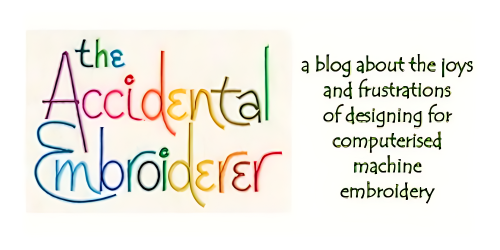Strippy purse: the stitchouts
I finally managed to digitise the flowers for Cherri's purse (the one made from long, narrow strips of material) and she did the stitchouts. The flowers turned out well, and I'm pleased at the effect of the outlined leaves – it wouldn't have been as effective with solid leaves. I also like the black background that she gave the flowers
Sketches for a strippy purse
Cherri Kincaid and I have been discussing designs to go on a purse that she wants to sew. Here’s the pattern
http://www.indygojunctioninc.com/store/product_info.php?cPath=127&products_id=764
and you can see that the purse is made up of separate strips of fabric. This suggested the idea of flowers on long stems, each flower and stem fitting on a separate strip, so I’ve done a few quick sketches of some ideas. I’m not sure if I like them much as they are but they’ll probably be better once they’re digitised and stitched out. The colours will be stronger and there will be details on the flowers which will make them a little more interesting
Blue birds in a blue bush
Clip art complaint
Pheasant
Andalucian Birds
We spent some time in Andalucia a couple of years ago and I really liked the painted tiles that were used to decorate a lot of the houses, with simple, primitive pictures of birds and leaves and pomegranate fruits.
